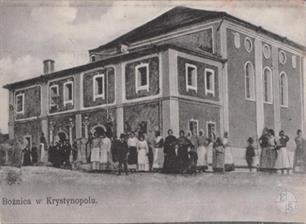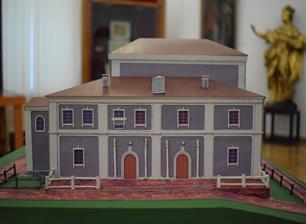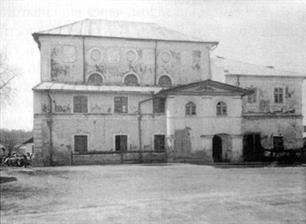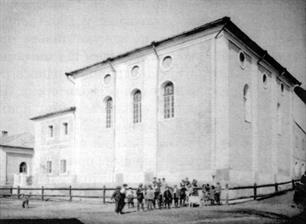Chervonohrad (Krystynopil)
Lviv region
Year - Total Population - Jews
1765 - ? - 759
1880 - 3,484 - 2,747
1900 - 3,522 - 2,651
1921 - 2,805 - 2,086
1765 - ? - 759
1880 - 3,484 - 2,747
1900 - 3,522 - 2,651
1921 - 2,805 - 2,086
Sources:
- Pinkas Hakehillot Polin: Encyclopedia of Jewish Communities, Poland, Volume II, page 494-495, published by Yad Vashem, Jerusalem. Translated by Jerrold Landau, JewishGen, Inc.
Photo:
- Национальный музей Львова
- Про Червоноград
- Pinkas Hakehillot Polin: Encyclopedia of Jewish Communities, Poland, Volume II, page 494-495, published by Yad Vashem, Jerusalem. Translated by Jerrold Landau, JewishGen, Inc.
Photo:
- Национальный музей Львова
- Про Червоноград
The private town of Krystynopol (ukr. Krystynopil, Кристинопіль - name until 1951; now - Chervonohrad, Червоноград) was founded in 1692 by the nobleman Count Szczesny Kazimierz Potocki, who called it after his name Krystyna. In 1722, after the death of the founder of the town and after the owner of the city at that time, Stanislaw Szczesny Potocki moved to Tulczyn, the town declined. However, it continued to be an important regional center of the grain trade until the middle of the 19th century, due to the large agricultural estates of the noblemen of the region.
In 1854, a fire broke out in Krystynopol that destroyed many houses. In the 19th century, there were liquor distilleries and beer breweries in the town, and during the 1880s, a small brick kiln was built. At that time, the town was connected by railway to the Sokal-Jaroslaw line.
The Russian Army conquered Krystynopol at the end of August or the beginning of September 1915, and caused great destruction. The town was reconquered by battalions of the Austrian Army in May 1915. In November 1919, Krystynopol was under the rule of the Republic of Western Ukraine. When the battalions of General Haller entered in June 1919, Polish rule was restored.
Apparently, the first Jews came to Krystynopol immediately after it was founded. On can see a sign of the relative population increase of the Jewish population in the early era of the existence of Krystynopol from the sum of the head tax that had to be paid to the royal treasury. In 1717, the sum was 200 zloty.
In 1765, the number of head tax payers in Krystynopol reached 759, which implies that the Jewish population consisted of 800-850 souls. Due to the lack of data on the terms of residency, the fundamental rights, and occupation of the Jews; we can only infer from the other private cities of the Potockis that the Jews enjoyed relatively liberal fundamental rights, such as the right to conduct commerce and engage in trades without restrictions, and to conduct their internal matters according to Jewish law, with everything being under the supervision of the court and treasury of the owners of the city.
The source of livelihood of the first Jews in Krystynopol was connected to the leasing of the produce of the estates of the city owners and the income of the court. The population of the town was composed mainly of Jews (75% of the total population), and it continued to be “Jewish” until 1939.
The gentile residents of Krystynopol lived in its suburbs, and occupied themselves with agriculture or related trades (smiths, coopers, etc.). All of the commerce, primarily the grain trade but also other areas of business, was in the hands of the Jews. This situation did not change even in the wake of the legal changes that took place with respect to private cities at the beginning of the Austrian era.
In actuality, the residents of the place, including the Jews, continued to be economically dependent on the court of the owners of the city until they sold their estates in 1880. They were dependent on the laws and conventions that were in place throughout Galicia from a physical and administrative perspective.
It is no wonder, therefore, that the population of the town declined after the sale of the estates by their owners. This situation did not fundamentally change even when the town was connected to the railway line.
At first, the Jews of Krystynopol were dependent on the community of Sokal or Belz - the regional city. However, in the latter half of the 18th century, they became independent, set up their own institutions, and had their own rabbi.
During those years, Rabbi Meir the son of Rabbi Tzvi-Hirsch HaLevi served as the rabbi of Krystynopol. He was given the nickname “The Krystynopoler” on account of his place of tenure, and he was the author of “Yad Hameir”. He became the rabbi of Brody in 1785, and was even appointed as the district rabbi (Kreizrabbiner) there.
Rabbi Yitzchak, the author of “Yesod Brit Yitzchak” succeeded him in the rabbinate. At the beginning of the 18th century, Rabbi Tzvi served as the rabbi of Krystynopol (he died in 1820). Members of the famous Teomim rabbinical family served in the rabbinate of Krystynopol for consecutive years until the Holocaust. The first one of them, Rabbi Efraim the son of Rabbi Moshe, served until 1879. His son Rabbi Yitzchak, formerly the rabbi of Sniatyn and Wielkie Oczy, inherited the rabbinate from him. After his death in 1911, his son Rabbi Avraham took over the rabbinate. He served until the Holocaust, and he perished along with his son Rabbi Moshe.
In Krystynopol, which was near Belz, most of the Jews were Hassidim of Belz. That Hassidic group had complete control over the community. Under their influence, until the First World War no secular movement was permitted to gain a foothold in the town. Therefore, modern educational systems were not established.
Very few Jewish children studied in the public school, which only had two grades. In 1895, Sheinfeld, one of the wealthy men of Krystynopol who apparently had become enamored with modern ideas, was so brazen as to give over his home for the establishment of a school in the name of Baron Hirsch. However, his efforts did not succeed.
In 1908, several local people attempted to set up a Zionist organization, but it ceased its activities after eight months under pressure from the regional governor (apparently under the influence of the community leadership). During the parliamentary elections of 1912, a general meeting took place in the synagogue, at which Dr. Izador Schneider spoke. Spiegel, the head of the community at that time, summoned the police, and the speaker was imprisoned and transported by the police to nearby Sokal.
In 1854, a fire broke out in Krystynopol that destroyed many houses. In the 19th century, there were liquor distilleries and beer breweries in the town, and during the 1880s, a small brick kiln was built. At that time, the town was connected by railway to the Sokal-Jaroslaw line.
The Russian Army conquered Krystynopol at the end of August or the beginning of September 1915, and caused great destruction. The town was reconquered by battalions of the Austrian Army in May 1915. In November 1919, Krystynopol was under the rule of the Republic of Western Ukraine. When the battalions of General Haller entered in June 1919, Polish rule was restored.
Apparently, the first Jews came to Krystynopol immediately after it was founded. On can see a sign of the relative population increase of the Jewish population in the early era of the existence of Krystynopol from the sum of the head tax that had to be paid to the royal treasury. In 1717, the sum was 200 zloty.
In 1765, the number of head tax payers in Krystynopol reached 759, which implies that the Jewish population consisted of 800-850 souls. Due to the lack of data on the terms of residency, the fundamental rights, and occupation of the Jews; we can only infer from the other private cities of the Potockis that the Jews enjoyed relatively liberal fundamental rights, such as the right to conduct commerce and engage in trades without restrictions, and to conduct their internal matters according to Jewish law, with everything being under the supervision of the court and treasury of the owners of the city.
The source of livelihood of the first Jews in Krystynopol was connected to the leasing of the produce of the estates of the city owners and the income of the court. The population of the town was composed mainly of Jews (75% of the total population), and it continued to be “Jewish” until 1939.
The gentile residents of Krystynopol lived in its suburbs, and occupied themselves with agriculture or related trades (smiths, coopers, etc.). All of the commerce, primarily the grain trade but also other areas of business, was in the hands of the Jews. This situation did not change even in the wake of the legal changes that took place with respect to private cities at the beginning of the Austrian era.
In actuality, the residents of the place, including the Jews, continued to be economically dependent on the court of the owners of the city until they sold their estates in 1880. They were dependent on the laws and conventions that were in place throughout Galicia from a physical and administrative perspective.
It is no wonder, therefore, that the population of the town declined after the sale of the estates by their owners. This situation did not fundamentally change even when the town was connected to the railway line.
At first, the Jews of Krystynopol were dependent on the community of Sokal or Belz - the regional city. However, in the latter half of the 18th century, they became independent, set up their own institutions, and had their own rabbi.
During those years, Rabbi Meir the son of Rabbi Tzvi-Hirsch HaLevi served as the rabbi of Krystynopol. He was given the nickname “The Krystynopoler” on account of his place of tenure, and he was the author of “Yad Hameir”. He became the rabbi of Brody in 1785, and was even appointed as the district rabbi (Kreizrabbiner) there.
Rabbi Yitzchak, the author of “Yesod Brit Yitzchak” succeeded him in the rabbinate. At the beginning of the 18th century, Rabbi Tzvi served as the rabbi of Krystynopol (he died in 1820). Members of the famous Teomim rabbinical family served in the rabbinate of Krystynopol for consecutive years until the Holocaust. The first one of them, Rabbi Efraim the son of Rabbi Moshe, served until 1879. His son Rabbi Yitzchak, formerly the rabbi of Sniatyn and Wielkie Oczy, inherited the rabbinate from him. After his death in 1911, his son Rabbi Avraham took over the rabbinate. He served until the Holocaust, and he perished along with his son Rabbi Moshe.
In Krystynopol, which was near Belz, most of the Jews were Hassidim of Belz. That Hassidic group had complete control over the community. Under their influence, until the First World War no secular movement was permitted to gain a foothold in the town. Therefore, modern educational systems were not established.
Very few Jewish children studied in the public school, which only had two grades. In 1895, Sheinfeld, one of the wealthy men of Krystynopol who apparently had become enamored with modern ideas, was so brazen as to give over his home for the establishment of a school in the name of Baron Hirsch. However, his efforts did not succeed.
In 1908, several local people attempted to set up a Zionist organization, but it ceased its activities after eight months under pressure from the regional governor (apparently under the influence of the community leadership). During the parliamentary elections of 1912, a general meeting took place in the synagogue, at which Dr. Izador Schneider spoke. Spiegel, the head of the community at that time, summoned the police, and the speaker was imprisoned and transported by the police to nearby Sokal.
In the first weeks after the outbreak of the First World War, the town was conquered by the Cossacks, who perpetrated a pogrom against the local Jews. They caused great destruction to the houses (many of which were set on fire), and pillaged almost all of the shops. Three Jews were shot, and two were stabbed to death. Approximately 30 women were raped - the married ones in the presence of their husbands. People of the neighboring villages participated in the pillage. A few days after the pogrom, the leadership of the army stationed in the city issued a command that all of the men between the ages of 18-50 must leave the city. The Jewish Aid Committee of Kiev came to the help of those who remained. Its representative was the writer A. Anski, who passed through the town during those days and gave the communal council 500 rubles for the initial assistance.
After Krystynopol was conquered by brigades of the Austrian Army, life in the town did not return to its normal path until the end of the First World War. The Jews of Krystynopol continued to endure trials and tribulations during the first months of the rule of the Republic of Western Ukraine (November 1915-June 1919), as well as the unrest that pervaded during the first days of the renewed Polish government.
Approximately 1,000 former residents of the town did not return to live there after the wartime tribulations. The economic decline that had already begun during the 1880s worsened. The relatively large scale grain trade ceased. Most of the merchants of the city were occupied with small-scale commerce or peddling in the villages. The decreased scope of economic activity can be seen from the sums of the loans granted to borrowers by the charitable fund (established in 1927): 1929 -- 55 loans for a total of 5,200 zloty, 1933-1934 -- 24 loans totaling 1,885 zloty, 1936-1937 -- 81 loans totaling 4,184 zloty. The borrowers in 1936-1935 consisted of 35 tradesman and 47 small scale businessmen.
Whereas the economic life in the town was frozen between the two world wars, the communal life underwent significant changes. In 1927, the local rabbi, assisted by the police, still had the right to interfere with the dance parties set up by the Zionist youth. However, during that time, Zionist organizations were set up and developed in Krystynopol, including Hitachdut, Mizrachi, and the General Zionists.
In 1935, a Zionist youth organization was established, with a library attached to it. Later, and Gordonia chapter was established.
In 1922, Hebrew languages courses were offered. Thirty students attended. In 1923-1924, courses by the “Union of Public and High Schools” of Lwow were offered. Despite the efforts of the Belz Hassidim to vote for the Polish government list, the local Jews gave their votes to the national-Zionist list -- 866 votes in the Sejm election of 1922, and 605 votes in the 1928 election.
In 1931, 160 paid members were able to vote for the Zionist Congress, and in 1935, there were already 497 paid members, of which 103 voted for the General Zionist list, 144 for the Mizrachi, 241 for the Working Land of Israel list, 7 for the State party, and 4 for the Hashachar list. The Zionists also gained a foothold in the town council. In the elections of 1927, the Jews received 20 mandates out of a total of 31; including 6 Zionist and 4 representatives of the Yad Charutzim, none of whom were connected to the Belzer Hassidim.
During the last years before the Second World War, the Jewish peddlers ran into difficulties when returning from the villages. There were attacks, and some of them were even beaten.
With the beginning of the war in September 1939, Krystynopol transferred from authority to authority several times. At first it was conquered by the Germans. Then it returned to the Polish Army for a brief period before returning once again to the Germans, who took revenge on the town by burning a significant portion of it and murdering approximately 20 Jews.
The Soviets entered the town at the end of September. When the border between the Soviet Union and Germany was established at the Bug River, Krystynopol was finally transferred to the Germans. Before their retreat, the Soviet authorities turned to the residents, most of whom were Jewish, and asked them to cross over the Bug with them. Almost all of the Jews crossed over to the other bank of the Bug at that time or during the first weeks of German rule. They went to Sokal and Novyy Vitkov, which remained in Soviet hands until the outbreak of the war with Germany on June 22, 1941.
The Jewish community of Krystynopol already ceased to exist at the end of September and the beginning of October 1939.
After Krystynopol was conquered by brigades of the Austrian Army, life in the town did not return to its normal path until the end of the First World War. The Jews of Krystynopol continued to endure trials and tribulations during the first months of the rule of the Republic of Western Ukraine (November 1915-June 1919), as well as the unrest that pervaded during the first days of the renewed Polish government.
Approximately 1,000 former residents of the town did not return to live there after the wartime tribulations. The economic decline that had already begun during the 1880s worsened. The relatively large scale grain trade ceased. Most of the merchants of the city were occupied with small-scale commerce or peddling in the villages. The decreased scope of economic activity can be seen from the sums of the loans granted to borrowers by the charitable fund (established in 1927): 1929 -- 55 loans for a total of 5,200 zloty, 1933-1934 -- 24 loans totaling 1,885 zloty, 1936-1937 -- 81 loans totaling 4,184 zloty. The borrowers in 1936-1935 consisted of 35 tradesman and 47 small scale businessmen.
Whereas the economic life in the town was frozen between the two world wars, the communal life underwent significant changes. In 1927, the local rabbi, assisted by the police, still had the right to interfere with the dance parties set up by the Zionist youth. However, during that time, Zionist organizations were set up and developed in Krystynopol, including Hitachdut, Mizrachi, and the General Zionists.
In 1935, a Zionist youth organization was established, with a library attached to it. Later, and Gordonia chapter was established.
In 1922, Hebrew languages courses were offered. Thirty students attended. In 1923-1924, courses by the “Union of Public and High Schools” of Lwow were offered. Despite the efforts of the Belz Hassidim to vote for the Polish government list, the local Jews gave their votes to the national-Zionist list -- 866 votes in the Sejm election of 1922, and 605 votes in the 1928 election.
In 1931, 160 paid members were able to vote for the Zionist Congress, and in 1935, there were already 497 paid members, of which 103 voted for the General Zionist list, 144 for the Mizrachi, 241 for the Working Land of Israel list, 7 for the State party, and 4 for the Hashachar list. The Zionists also gained a foothold in the town council. In the elections of 1927, the Jews received 20 mandates out of a total of 31; including 6 Zionist and 4 representatives of the Yad Charutzim, none of whom were connected to the Belzer Hassidim.
During the last years before the Second World War, the Jewish peddlers ran into difficulties when returning from the villages. There were attacks, and some of them were even beaten.
With the beginning of the war in September 1939, Krystynopol transferred from authority to authority several times. At first it was conquered by the Germans. Then it returned to the Polish Army for a brief period before returning once again to the Germans, who took revenge on the town by burning a significant portion of it and murdering approximately 20 Jews.
The Soviets entered the town at the end of September. When the border between the Soviet Union and Germany was established at the Bug River, Krystynopol was finally transferred to the Germans. Before their retreat, the Soviet authorities turned to the residents, most of whom were Jewish, and asked them to cross over the Bug with them. Almost all of the Jews crossed over to the other bank of the Bug at that time or during the first weeks of German rule. They went to Sokal and Novyy Vitkov, which remained in Soviet hands until the outbreak of the war with Germany on June 22, 1941.
The Jewish community of Krystynopol already ceased to exist at the end of September and the beginning of October 1939.

- Home
- Shtetls
- Vinnytsia region
- Volyn region
- Dnipro region
- Donetsk region
- Zhytomyr region
- Zakarpattia region
- Zaporizhzhia region
- Ivano-Frankivsk region
- Kyiv region
- Kropyvnytskyi region
- Luhansk region
- Lviv region
- Mykolayiv region
- Odessa region
- Poltava region
- Rivne region
- Sumy region
- Ternopil region
- Kharkiv region
- Kherson region
- Khmelnytskyi region
- Chernihiv region
- Chernivtsi region
- Cherkasy region
- Crimea
- Synagogues
- Cemeteries
- Objects & guides
- Old photos
- History
- Contact
Jewish towns of Ukraine
Jewish towns of Ukraine
My shtetl
My shtetl
Donate




